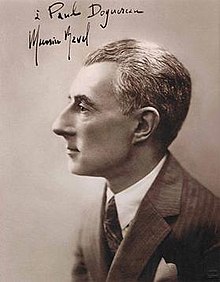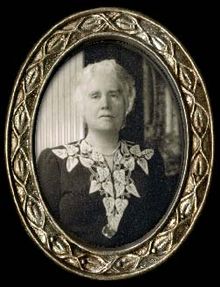Paul Doguereau
Paul René Doguereau | |
|---|---|
piano teacher |
Paul René Doguereau (September 8, 1908 – March 3, 2000) was a French
Education
Although he officially studied with
According to Doguereau's adopted son,[citation needed] the pianist, author, and musicologist Harrison Slater:
At the time Paul was preparing for his exam for the Premier Prix of the Conservatoire (part of the exam required everyone to learn several standard piano repertoire works in a given brief time period). One of the pieces was the
Symphonic Etudes of Schumann, and Paul practiced them directly across the window from Roger-Ducasse. In fact, he practiced them for hours on end (easily, seven-and-a-half to eight hours a day). Roger-Ducasse sent Paul a note asking him, "Don't you ever stop playing to pee?" The implication was, as Paul told it, that all Paul's practicing was keeping Roger-Ducasse from composing, hence the humorous note with the undertones of frustration. Whenever Paul spoke of Roger-Ducasse, it was with extraordinary reverence and respect.[5]
Doguereau told his pupil, the pianist David Korevaar, that he had learned much about playing
Later, Doguereau took ten lessons with
Professional life

Doguereau met
According to Slater:
Part of Paul's job (in general, not just with Ravel) was determining which notes on the rolls were wrong, and indicating it to the technicians. When making the Duo-Art rolls, certain passages scared Ravel, such as something as simple as an octave passage in two hands, where he asked Paul to play the lower notes of the octave along with him. When the time came, however, he was able to do it himself, and didn't avail himself of Paul's help.
Ravel also told Paul that, "when he wrote
Gaspard de la Nuit, he was able to play it all". That included "Scarbo". Paul was skeptical that Ravel could play "Scarbo", and repeated his skepticism for years.[5]
They remained friends, and Doguereau spoke to Korevaar of visiting Ravel at his home in Montfort, France in later years. There is a photo of Ravel inscribed to Doguereau in the living room of his Boston home.[5]
Performance
Doguereau performed in Europe in the 1920s and 1930s. He organized concerts, including one by
Doguereau lived in Boston for over sixty years. He met Fanny Peabody Mason in 1937 and it proved to be a meeting that would influence the Boston music scene for decades to come. After her death, Doguereau continued her musical tradition by using the trust left to him to establish the Peabody-Mason Music Foundation, which presented concert performances in Boston for 35 years. On a few occasions Doguereau himself accompanied other artists in their performance. Doguereau's performance legacy lives on in his students, including Earl Wild,[7] Peter Orth, David Korevaar, Sergey Schepkin, Andrew Rangell, Harrison Slater, Robert Swan, Stephen Porter and Robert Taub.
Recordings
Doguereau left little in the way of recorded performances. Given that he stopped performing in public in the 1950s, this is hardly surprising. He did however continue to perform privately, and in the last year of his life played the last two Chopin Ballades for friends twice at his home in Mt. Holly, New Jersey.[7]
The earliest recording found by David Korevaar was a piano roll of the Danse Russe from
In addition, Doguereau recorded solo repertoire for Technichord that was never released – perhaps the recordings were not up to his exacting standards. Dr. David Korevaar, a former student of Doguereau, was able to study the solo material held by the Library of Congress. The recordings include performances of Ravel's Sonatine (although missing the second part of the first movement), Fauré's Third Barcarolle, and Bach's Chromatic Fantasie.[10]
After hearing the recordings, Korevaar commented:
The performances are all excellent, with brisk tempos and a lack of sentimentality that suits the French repertoire well. The piano sound is surprisingly clean and beautiful; every detail of the performance is audible on the recording. In terms of style, the Ravel is clear, unsentimental, and the last movement is brilliant.[5]
Korevaar found these recorded tempi to be even faster than the indications given by Doguereau when Korevaar studied the work with him, although the high pitch of the transfer may be partly the cause. The recording of Fauré's Barcarolle has some rubati in the opening. This caught David Korevaar's attention because he studied the work with Doguereau and remembered his demonstrating in this style.[5]
Boston concerts and competitions

Miss Fanny Peabody Mason, was until her death in 1948, an active patron of music both in the United States and abroad. Her musical interests were piano, singing and chamber music.[6] Miss Mason had met Doguereau early in his career and they became lifelong friends. Mason and Doguereau shared a vision of presenting classical music as a gift to general audiences. Bringing this vision to reality, Mason was benefactress of the Peabody Mason Concerts which Doguereau directed for 35 years bringing the best talent to Boston audiences, at the best venues, with no admission charge. Rudolph Elie of the Boston Herald hailed the Peabody Mason Concerts, "...of which Paul Doguereau, is at once one of the finest pianists in residence in the city and a musician of great discernment and sensibility, is the guiding spirit."[11] Doguereau was a Fellow of the American Academy of Arts and Sciences, and frequently organized performances at the Academy.
Doguereau also organized the early Peabody Mason Piano Competitions, where he served as President and Artistic Director. The piano competition was inspired by Miss Mason's commitment to, and aspirations for, the arts and serves to showcase and encourage emerging piano talent. The first competition was held in 1981, with others following in 1984 and 1985. The grand prize winner received a yearly stipend plus a New York City and a Boston recital. The competition's rich heritage, its intermittent nature, and its generous prize have led to a significant reputation and cachet for the award.
A resident of Boston, Doguereau maintained a home in
See also
References
- ^ Associated Press, 5-Mar-2000, Obituary
- ^ a b New York Times, 9-Mar-2000, Obituary
- ^ Boston Herald, 3-Mar-2000, Obituary
- ^ a b Richard Dyer, 10-Mar-2000, The Boston Globe, "Farewell to a Legend"
- ^ a b c d e f g h i Korevaar, David (2007). A link to the French pianistic tradition: the teaching of Paul Doguereau. French Music: Performance and Analysis. Laie, Hawaii: Brigham Young University Hawaii.
- ^ a b Harrison Gradwell Slater, "Behind Closed Doors", Keyboard Classics, 1987
- ^ a b New York Times, 23-Jan-2010, Allan Kozinn, "Earl Wild, Pianist, dies at 94" NY Times online
- ^ Albert M. Petrak, ed., "Ampico Catalog", p. 38, Roll No. 6686.
- ^ Musical Quarterly, Quarterly Record List, vol. 34, no. 3 (1948): 459
- ^ Library of Congress, H. Vose Greenough, Jr. Paper Collection, "H. Vose Greenough Collection"
- ^ Rudolph Elie, 28-Apr-1950, Boston Herald, "Chamber Concert"
- ^ Staff. "Paul R. Doguereau, Pianist and Mentor", The Philadelphia Inquirer, March 11, 2000. Accessed March 1, 2011. "Paul Rene Doguereau, 91, a pianist and interpreter of French music as well as a teacher and mentor to many younger pianists, died March 3 in the Virtua-Mount Holly Center, Mount Holly. A resident of Boston for more than 60 years, he and his adopted son, Harrison James Wignall, also maintained a home in Mount Holly for the last 2 1/2 years. He had stayed in Mount Holly since last March and in the nursing home for the last several months."
External links
- David Korevaar website
- Harrison Slater website
- As of this edit, this article uses content from "Biography", which is licensed in a way that permits reuse under the Creative Commons Attribution-ShareAlike 3.0 Unported License, but not under the GFDL. All relevant terms must be followed.
